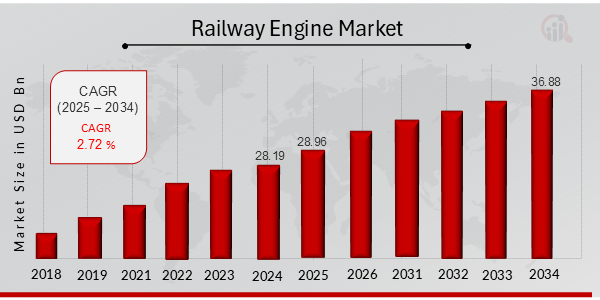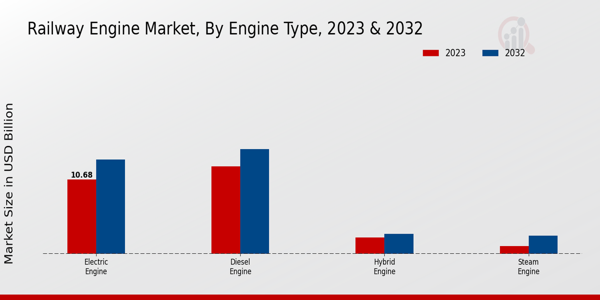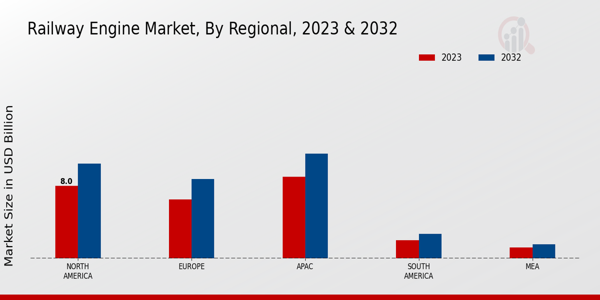Railway Engine Market Overview:
As per MRFR analysis, the Railway Engine Market Size was estimated at 28.19 (USD Billion) in 2024. The Railway Engine Market Industry is expected to grow from 28.96 (USD Billion) in 2025 to 36.88 (USD Billion) till 2034, at a CAGR (growth rate) is expected to be around 2.72% during the forecast period (2025 - 2034).
Key Railway Engine Market Trends Highlighted
The global railway engine market is driven by various factors, including the increasing need for efficient and sustainable transportation solutions. Rising urbanization and population growth are pushing governments to invest in railway infrastructure, making rail a preferred modality for both passengers and freight.
Furthermore, advancements in technology, such as electrification and automation, are transforming traditional rail systems into more modern and reliable networks.
These driving forces underline the importance of railways in reducing congestion and minimizing the carbon footprint associated with road transport. As the market evolves, several opportunities are emerging.
One significant area is the development of hybrid and electric engines, which align with global sustainability goals. There is also potential for retrofitting existing engines to enhance performance and reduce emissions.
With many countries working towards integrating renewable energy into their rail systems, companies that can innovate and offer eco-friendly solutions will find a receptive market. Additionally, the push for high-speed rail networks presents opportunities for manufacturers to cater to evolving consumer demands.
Recent trends indicate a shift towards digitalization and smart technology applications in rail systems. The introduction of predictive maintenance, the Internet of Things (IoT), and data analytics is enhancing operational efficiency and safety.
Alongside this, public-private partnerships are becoming increasingly common to fund and develop railway projects, which can lead to further innovation and modernization. The focus on passenger experience, including comfort and accessibility, is also shaping product development in the railway sector.
All these factors are contributing to a dynamic landscape that is set to evolve over the coming years.

Source: Primary Research, Secondary Research, Market Research Future Database and Analyst Review
Railway Engine Market Drivers
Growing Demand for Sustainable Transportation Solutions
One of the most significant drivers in the global railway engine market is the increasing demand for sustainable transportation solutions. As global awareness about environmental issues heightens, governments and corporations are under increasing pressure to reduce carbon emissions and promote greener modes of transport.
Rail transport is recognized as one of the most efficient and environmentally friendly forms of transportation, especially for bulk goods and passengers over long distances. This paradigm shift is encouraging investment in advanced railway engines that are designed to minimize environmental impact.
The adoption of electric and hybrid railway engines is on the rise, aligning with the global push toward sustainability. Furthermore, innovations in energy efficiency within the railway engine design are becoming priorities for manufacturers as they strive to create engines that not only perform effectively but also adhere to tightening regulatory frameworks concerning emissions.
The continued evolution of battery technology and alternative fuel sources like hydrogen adds another layer of potential to this segment, as the industry aims to transition towards cleaner alternatives swiftly.
By incorporating advanced technology into the railway systems, stakeholders can boost operational efficiency, reduce running costs, and ultimately create a more sustainable transport ecosystem. As such, the rising importance of sustainability is likely to remain a crucial growth factor in the global railway engine market.
Infrastructure Development and Government Investments
Infrastructure development plays a pivotal role in the expansion of the global railway engine market. Many countries are investing heavily in modernizing their railway networks to enhance efficiency and support growing urban populations.
Government investments in rail infrastructure not only create demand for more advanced railway engines but also facilitate the integration of high-speed rail and metro systems. These developments require robust and efficient engines capable of handling increased passenger and freight loads.
Technological Advancements in Railway Systems
Technological advancements are driving innovation within the global railway engine market. New technologies such as automation, improved safety systems, and enhanced fuel efficiency are enhancing the performance and reliability of railway engines.
Manufacturers are increasingly adopting digital technologies for predictive maintenance, resulting in less downtime and higher operational efficiency. This trend not only improves service quality but also attracts more passengers to rail travel.
Railway Engine Market Segment Insights:
Railway Engine Market Engine Type Insights
The global railway engine market revealed a nuanced segmentation along the engine type, showcasing diverse technologies that cater to varying operational needs and environmental considerations.
The electric engine segment emerged as a key player with a valuation of 10.68 USD billion in 2023 and is projected to reach 13.5 USD billion by 2032. This segment is significant due to its efficiency and reduced environmental impact, propelling its increasing adoption in urban transit systems.
The diesel engine, holding a valuation of 12.55 USD billion in 2023 and expected to grow to 15.0 USD billion in 2032, dominated this market, primarily due to its reliability and the existing infrastructure suited for diesel-powered trains, especially in freight operations and remote areas.
Hybrid engines accounted for a valuation of 2.34 USD billion in 2023 and are seen as a significant innovation blending traditional power with electric assistance, projected to enhance performance levels while abiding by stricter environmental regulations.
Meanwhile, the steam engine, although a more historical technology, showed a valuation of 1.15 USD billion in 2023 and is poised for growth to 2.65 USD billion by 2032. Its niche applications in heritage railways and tourist services reflect ongoing interest, albeit it remains the least dominant among these types.
Collectively, the global railway engine market data indicates distinct pathways for growth driven by technological advancements and a shift towards sustainable transport solutions, shaping the industry's future landscape.
The inherent market dynamics across these types illustrate varying demand drivers, with key opportunities arising from innovation and environmental policies influencing market growth trajectories.

Source: Primary Research, Secondary Research, Market Research Future Database and Analyst Review
Railway Engine Market Power Output Insights
The Power Output segment of the global railway engine market plays a crucial role in dictating the overall dynamics and trends within the industry. The market encompasses various categories, including below 500 HP, 500-1000 HP, 1000-1500 HP, and above 1500 HP, each reflecting unique operational capabilities suited for differing grid applications.
The below 500 HP category is essential as it fulfills the demand for locomotives in light freight and commuter services, while the 500-1000 HP range serves regional transport needs efficiently. The 1000-1500 HP segment has gained traction due to its versatility, operating effectively in both freight and passenger services, contributing significantly to the global railway engine market revenue.
Meanwhile, the above 1500 HP category dominates heavier freight applications, catering to bulk transport requirements and showcasing a robust demand given global trade expansion. This segmentation allows stakeholders to strategize better, addressing the diverse operational requirements of rail transport while adapting to emerging trends like sustainability and technological advancements.
The continuous evolution seen across different power outputs reflects the broader transformation within the global railway engine market, enhancing performance and efficiency on tracks.
Railway Engine Market Locomotive Type Insights
The global railway engine market focuses on various locomotive types, creating a diverse landscape characterized by distinct functional roles. Freight locomotives exhibit significant importance due to their ability to handle large volumes of cargo, thus playing a crucial role in logistics and supply chains.
Meanwhile, passenger locomotives cater to a growing demand for efficient and comfortable travel, particularly in urban areas, enhancing the overall rail experience.
Switch locomotives facilitate operational efficiency by optimizing rail yard functionalities, while high-speed locomotives are reshaping intercity transit, providing rapid connectivity and encouraging reduced travel times.
These segments contribute to the global railway engine market data by responding to shifting consumer preferences and supporting infrastructural advancements, with trends leaning towards sustainability and efficiency.
Market growth is further supported by technological innovations in locomotive design and increasing investments in rail infrastructure worldwide, even as challenges such as regulatory compliance and competition from other transportation modes persist.
The global railway engine market statistics indicate a promising growth trajectory fueled by the evolving dynamics of these locomotive types.
Railway Engine Market Application Insights
The segmentation of the global railway engine market reveals key areas, including freight transport, passenger transport, maintenance of way, and construction. Freight transport remains crucial as it accounts for the majority of railway cargo, driving infrastructure investments.
Passenger transport is also significant, as it emphasizes the need for efficient transit solutions in urban areas, contributing to environmental sustainability efforts. Similarly, maintenance of way is vital for ensuring safety and operational efficiency, underpinning the reliability of railway networks.
The construction aspect continues to grow as investments in rail infrastructure rise globally, fueled by increasing urbanization and demand for improved connectivity. These components collectively contribute to the overall dynamics of the market, influencing its growth trajectory and addressing the evolving transportation needs of society.
Moreover, ongoing technological advancements and sustainable practices present opportunities while also posing challenges, particularly in balancing modernization with cost management. The reliable data on the global railway engine market statistics demonstrates how these applications interconnect and drive industry progress.
Railway Engine Market Regional Insights
North America led the market with a valuation of USD 8.0 billion, driven by advancements in rail infrastructure and technology, alongside increasing investments in freight systems. Europe followed closely with a total of USD 6.5 billion, notable for its established railway networks and stringent environmental regulations promoting cleaner engines.
The APAC region, valued at USD 9.0 billion, held the majority, indicating substantial demand driven by urbanization and expanding industrial activities, marking it as a dominant player in the global railway engine market.
Meanwhile, South America and MEA were relatively smaller markets, valued at USD 2.0 billion and USD 1.22 billion, respectively, reflecting growth opportunities arising from modernization efforts and increased trade links.
The regional segmentation unveils critical market data and statistics, revealing diverse growth drivers and challenges, making it imperative for stakeholders to consider region-specific strategies for enhanced market growth.

Source: Primary Research, Secondary Research, Market Research Future Database and Analyst Review
Railway Engine Market Key Players and Competitive Insights:
The global railway engine market is characterized by a diverse array of players competing in an environment marked by technological advancements, evolving consumer demands, and increasing governmental focus on sustainable transportation solutions.
This market is heavily influenced by the need for energy-efficient engines, bolstered by a demand for reduced carbon emissions and lower operational costs. As countries expand their rail networks and upgrade existing infrastructures, innovations in railway technology become central to competitive positioning.
The competitive landscape features both established manufacturers and emerging companies vying for market share, with investments directed toward research and development to enhance performance, reliability, and environmental sustainability capabilities.
Kawasaki Heavy Industries is a formidable contender within the global railway engine market, known for its robust engineering expertise and a long-standing history of innovation. The company has made significant strides in developing advanced rail technology that prioritizes fuel efficiency and reduces the environmental impact of railway operations.
Kawasaki Heavy Industries' commitment to quality and reliability positions it favorably among customers seeking dependable railway engine solutions. Furthermore, its integration of cutting-edge technologies, such as hybrid and electric propulsion systems, strengthens its competitive edge in a market increasingly focused on sustainability.
Thus, Kawasaki Heavy Industries excels in maintaining a strong market presence and continues to be a driving force in the development and provision of high-performance railway engines. Voith is an established name in the global railway engine market, recognized for its extensive experience and expertise in providing innovative drive systems and components.
The company's strength lies in its ability to offer customized solutions tailored to the specific needs of railway operators, helping them enhance operational efficiency and overall performance. Voith's engineering capabilities are complemented by a strong focus on sustainability, aligning with global trends toward greener transport solutions.
It leverages advanced technology and research initiatives to improve the durability and functionality of its products. With a commitment to quality service and customer satisfaction, Voith effectively consolidates its position in the railway engine sector, contributing significantly to the ongoing evolution of rail technologies across the globe.
Key Companies in the railway engine market Include:
- Kawasaki Heavy Industries
Railway Engine Market Developments
Recent developments in the global railway engine market reveal a growing trend towards electrification and sustainability. Major companies such as Siemens, Alstom, and CRRC Corporation are investing heavily in electric and hybrid engines to meet stringent emissions regulations and increasing environmental concerns.
In particular, Siemens has unveiled its latest electric locomotive, promising enhanced performance and efficiency. Meanwhile, Bombardier and Hitachi are collaborating on breakthrough technologies focused on energy efficiency, marking a shift in the industry towards greener solutions.
Mergers and acquisitions are shaping the competitive landscape, with GE Transportation recently acquiring a key technology firm to enhance its product offerings. Knorr-Bremse is also reported to be in discussions for potential acquisitions to expand its market reach within Europe.
The financial performance of these companies is on an upward trajectory, reflecting the overall market growth driven by rising demand for rail transport, especially in emerging markets where infrastructure projects are rapidly advancing. As a result, strategic partnerships and innovations are expected to further bolster the market, promoting technological advancements and improving service delivery within the sector.
Railway Engine Market Segmentation Insights
Railway Engine Market Engine Type Outlook
Railway Engine Market Power Output Outlook
Railway Engine Market Locomotive Type Outlook
Railway Engine Market Application Outlook
Railway Engine Market Regional Outlook
| Report Attribute/Metric |
Details |
|
Market Size 2024
|
28.19 (USD Billion)
|
|
Market Size 2025
|
28.96 (USD Billion)
|
|
Market Size 2034
|
36.88 (USD Billion)
|
|
Compound Annual Growth Rate (CAGR)
|
2.72% (2025 - 2034)
|
|
Report Coverage
|
Revenue Forecast, Competitive Landscape, Growth Factors, and Trends
|
|
Base Year
|
2024
|
|
Market Forecast Period
|
2025 - 2034
|
|
Historical Data
|
2019 - 2023
|
| Market Forecast Units |
USD billion |
| Key Companies Profiled |
Kawasaki Heavy Industries, Voith, Thales Group, Kadant, KnorrBremse, GE Transportation, Thales, Ansaldo STS, Trains and Railways, CRRC Corporation, Hitachi, Siemens, Alstom, Bombardier, Wabtec |
| Segments Covered |
Engine Type, Power Output, Locomotive Type, Application, Regional |
| Key Market Opportunities |
Electrification of railway networks, Adoption of green technologies, Development of high-speed trains, Expansion of freight transport solutions, Government investment in rail infrastructure |
| Key Market Dynamics |
Technological advancements, Eco-friendly initiatives, Demand for high-speed travel, Infrastructure investments, Growing urbanization |
| Countries Covered |
North America, Europe, APAC, South America, MEA |
Frequently Asked Questions (FAQ):
The global railway engine market is expected to be valued at 28.19 USD billion in 2024.
By 2034, the global railway engine market is projected to reach a value of 36.88 USD billion.
The expected CAGR for the global railway engine market from 2025 to 2034 is 2.72%.
In 2023, North America had the highest market value, totaling 8.0 USD billion.
The Electric Engine segment was valued at 10.68 USD billion in the global railway engine market for 2023.
Key players in the global railway engine market include Kawasaki Heavy Industries, Voith, Thales Group, and GE Transportation.
The Diesel Engine segment is projected to be valued at 15.0 USD billion by 2032.
In 2023, the Hybrid Engine segment was valued at 2.34 USD billion.

















